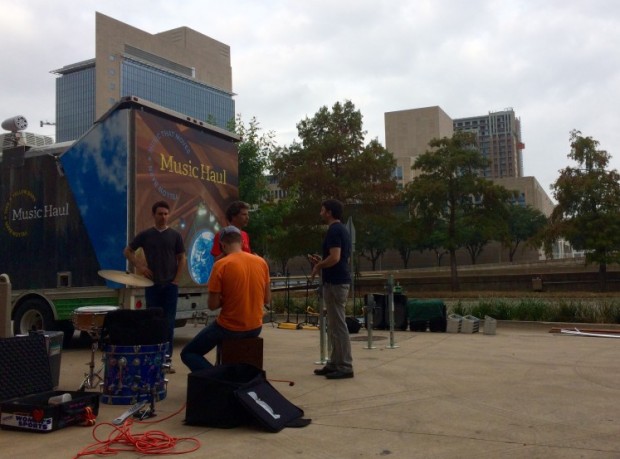
(Photo courtesy Nasher Sculpture Center)
Catherine Womak writes about Yellow Barn Music Haul for D Magazine:
When planning an outdoor concert, perhaps it’s not a great idea to center the program around not just one, but two pieces of music titled “It’s Gonna Rain” (by Steve Reich and the Sensational Nightingales respectively). On Thursday evening, as if taunted by the music itself, the Texas skies opened up and a massive rainstorm forced the Nasher’s planned outdoor Soundings concert indoors. Call it prophetic or serendipitous, but the end result was a mesmerizing display of reverberating sounds, an alternative musical experience that was just as fascinating (if not more so) than the one planned.
The consistently evocative and interesting concert series Soundings: New Music at the Nasher opened its sixth season Thursday night with a concert that was supposed to feature Yellow Barn’s Music Haul, an alternative, flexible outdoor concert “hall” that can transform any street corner into a performance venue.
Yellow Barn’s Music Haul is actually a used 17-foot U-Haul truck that has been retrofitted by a team of designers into a sort of traveling pop-up concert hall (think: the classical music equivalent of a food truck). Along with a talented troupe of musicians, the transformed U-Haul truck is wrapping up its inaugural tour this week in Dallas, where it was supposed to have been set up on Flora Street Thursday night for an outdoor Arts District performance (the group did perform outdoors Wednesday night in the Bishop Arts District under friendlier, dryer skies).
The music presented on this tour is typical of what you might expect from the Nasher’s Soundings series. Avant-garde and modern, this is music that some might view as inaccessible, the kind of art music that appeals to jazz geeks, contemporary-art-gallery-goers and music school nerds who never miss an episode of Meet the Composer. The Music Haul concept is interesting because it seeks to make this somewhat esoteric music accessible to a more diverse audience by performing, quite literally, for your average man or woman on the street. While I didn’t get to see it in action outdoors, I’d imagine the schtick works. Who wouldn’t stop, if even for a few minutes, to watch a mesmerizing accordion/violin duet, see an intricate piece of music played entirely on beer and liquor bottles, or watch as a musician performs hand gestures meticulously synchronized to recorded sounds?
On Thursday evening, the Music Haul truck was backed up to the Nasher’s front doors, but the music itself was moved out of the rain and into the museum’s main entry hall. To maintain the feel of a flexible outdoor concert, audience members were handed folding stools as they entered and instructed to position themselves wherever they wanted in the space. The eclectic program opened with music composed and performed by the fantastic concert accordionist Merima Ključo. In her hands, the accordion was transformed, blending beautifully with amplified violin and voice and expanding preconceived notions about the capabilities and qualities of the instrument.
Klujco was joined throughout the evening by percussionist Ian Rosenbaum, sound engineer Julian McBrowne and members of the band Rabbit Rabbit (Carla Kihlstedt and Matthias Bossi). Together they presented a mesmerizing and eccentric collection of pieces by living contemporary composers. The most recognizable name on the program was that of Steve Reich, whose It’s Gonna Rain, Part I (1965) and Music for Pieces of Wood (1973) were given memorable performances. Repetitive pulsations that would have dissipated in the open air reverberated deafeningly in the museum’s clean, empty space. The sound was intense and completely engrossing, making the music of the gospel quartet that followed it all the more refreshing.
Mark Applebaum’s Aphasia (2010), performed by Ian Rosenbaum, was one highlight of the night. The piece is as much performance art as it is music, and Rosenbaum’s stage presence was completely engrossing as he gestured in perfect synchronization to pre-recorded sounds. Rosenbaum also captured the audience’s attention with a focused, thoughtful performance of Christopher Cerrone’s Memory Palace, in which he played a prostrate, amplified guitar like a harp and transformed a collection of bottles into a complex instrument.
This was a fascinating and engaging evening of music that thoughtfully intertwined the familiar and the avant-garde. Indoors it was a more intense experience than it likely would have been on Flora Street. But if the goal of this project is to make experimental music more accessible, it will likely succeed wherever it lands, because engrossing performers like Rosenbaum, Kljuco and Rabbit Rabbit will capture audiences’ attention no matter how strange the sounds they make.
